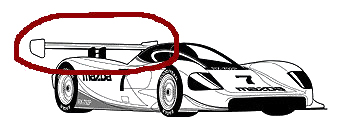Why do some cars, especially sports cars, have spoilers attached to the rear of the car?

It may be a bit unbelievable but some cars, especially race cars have spoilers to increase their grip on the road. When a car is moving at a high speed, the main requirement is stability and grip on the road. To increase the grip, one can increase the weight of the car or the way the tyres grip the road. But this is undesirable because they would hamper the high speed. The extra weight has inertia and a tighter tyre grip would mean more friction, more wear and tear of the tyre and hence more pit stops.
The other solution is to place a spoiler in the rear of the car. The way the spoiler works is like an airplane wing, but upside down. The spoiler actually generates what's called 'down force' on the body of the car.
Instead of having a heavy car, which is slow, or having a very light car, which can slide away easily, you now have a car that sticks better the faster it goes.
Every time a wind generates a down force it also generates drag. Drag is the natural reaction of the fluid (air) to resist motion through it (the car). Drag is bad, because it slows down the car.
Very high performance sports cars have a ratio called the 'lift/drag' ratio. The car designers try and maximize this so that the car has just enough force to get around the corners, but not so much that they are too slow.
Why do flags on a flag pole flap in wind?
When a flag is hoisted on a flagpole, if there is no breeze, the flag hangs down. But if there is breeze, the flag flaps on the pole. Why does it flap - have you ever wondered? The reason again is Bernoulli's principle. Imagine a perfectly smooth flag hanging on a pole. A strong wind on one side opens and spreads it up. A small perturbation or variation in air pressure in the wind will cause the speed of the air to vary on the flag surface. As the speed changes, air pressure on the opposite side of the flag surface changes; the change is exactly opposite to what is happening on the first side. This causes ripples on the flag surface. The ripples of wind are responsible for the flapping effects.
How is Bernoulli's principle related with bloodflow and heart attack?
Bernoulli's principle says that the sum of potential, kinetic and pressure energy per unit mass of a incompressible, non-viscous fluid remains constant. This principle explains blood flow in artery. The artery may get constricted due to accumulation of plague on its inner walls. For the blood to flow into the heart, a larger force is required. The force i.e, pumping of heart should be higher than the normal heart pump. The speed of the flow of the blood in this region is raised which lowers the pressure inside. Due to external pressure, the artery may collapse. To open this artery, the heart exerts more pressure and forces the blood through it. The internal pressure drops again leading to another collapse of the artery. This could result in heart attack.